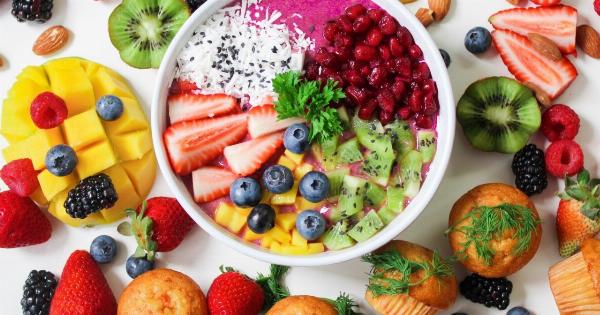Smoothies have become increasingly popular in recent years as a convenient and refreshing way to get a quick nutrient boost.
Whether you enjoy them for breakfast, as a post-workout snack, or as a meal replacement, smoothies offer a convenient way to pack a variety of fruits, vegetables, and other nutrient-rich ingredients into a single glass.
But while smoothies can be a great addition to a healthy diet, it’s important to consider whether your daily smoothie is actually good for you.
In this article, we will explore the benefits and potential drawbacks of consuming smoothies regularly, along with tips for creating healthier and well-balanced smoothie recipes.
The Benefits of Smoothies
One of the primary benefits of smoothies is their ability to provide a concentrated dose of vitamins, minerals, antioxidants, and other beneficial compounds found in fruits and vegetables.
By blending these ingredients, you break down the cell walls and make the nutrients more easily available for absorption by your body.
Smoothies can also be an excellent way to incorporate more fiber into your diet. Most fruits and vegetables are high in fiber, which aids in digestion, promotes gut health, and helps to keep you feeling fuller for longer.
Additionally, smoothies can be a convenient way to increase your intake of certain nutrients that you may struggle to get enough of through your regular diet.
For example, if you find it challenging to consume enough leafy greens, adding a handful to your smoothie can help ensure you’re meeting your body’s nutrient requirements.
The Drawbacks of Smoothies
While smoothies offer numerous health benefits, it’s important to be mindful of their potential drawbacks and pitfalls – especially if you’re relying on them as a daily meal replacement or snack.
One common issue with smoothies is their high sugar content. Fruits are naturally high in sugar, which can cause blood sugar spikes if consumed excessively.
To mitigate this, it’s crucial to balance your smoothie with other low-sugar ingredients, such as vegetables, healthy fats, and protein sources like Greek yogurt or nut butter.
Additionally, the act of blending can make it easier to consume larger portions than you would if eating whole foods. This can lead to calorie overload, potentially hindering weight loss or maintenance goals.
Controlling portion sizes and being mindful of the overall calorie content of your smoothie is essential for achieving a healthy balance.
Furthermore, some store-bought smoothies or smoothie recipes found online may contain added sugars, artificial sweeteners, or other unnecessary ingredients.
It’s crucial to read labels carefully and opt for homemade smoothies or those made with whole, real foods whenever possible. This way, you have full control over the ingredients and can ensure you’re nourishing your body with wholesome nutrients.
Tips for Creating a Nutritious and Well-Balanced Smoothie
To ensure your daily smoothie is truly good for you, it’s important to follow these tips for creating a nutritious and well-balanced blend:.
1. Include a Variety of Fruits and Vegetables
The foundation of a healthy smoothie is a diverse range of fruits and vegetables. Aim to include both in your blends to maximize the nutritional value.
Dark leafy greens like spinach, kale, or Swiss chard are particularly nutrient-dense and can easily be masked by fruits in terms of taste.
2. Add a Source of Protein
Including protein in your smoothie helps promote satiety and supports muscle recovery and growth. Greek yogurt, silken tofu, protein powder, or nuts and seeds can all be excellent protein sources to consider adding to your blend.
3. Include Healthy Fats
Healthy fats are essential for nutrient absorption and help to keep you feeling satisfied after consuming your smoothie. Avocado, nut butters, chia seeds, or a small amount of coconut oil are great options to incorporate into your recipe.
4. Consider Your Liquid Base
Choose your liquid base wisely, ensuring it complements the overall flavor profile and provides additional nutrients. Unsweetened almond milk, coconut water, or even plain water can make good choices.
Avoid using juices or sweetened beverages, as they can significantly increase the sugar content.
5. Don’t Forget Fiber and Superfood Boosters
Boost the fiber content of your smoothie by adding ingredients like ground flaxseed, oats, or psyllium husk. You can also consider incorporating superfoods like spirulina, matcha powder, or wheatgrass for an added nutrition punch.
6. Mindful Portions and Frequency
Pay attention to portion sizes and avoid overindulging in large servings. Depending on your specific calorie needs, it’s generally recommended to consume a smoothie as a meal replacement or snack, rather than in addition to your regular meals.
Moderation is key.
7. Experiment with Flavor and Texture
Have fun with your smoothie creations by experimenting with different flavor combinations and textures. Add spices like cinnamon or nutmeg, extracts like vanilla or almond, or fresh herbs like mint or basil to enhance the taste.
8. Listen to Your Body
Everyone’s nutritional needs are unique, so pay attention to how your body responds to daily smoothie consumption.
If you notice any negative effects like bloating, digestive discomfort, or blood sugar imbalances, consider adjusting the ingredients or frequency of your smoothie intake.
Conclusion
Smoothies can undoubtedly be a healthy addition to your diet, providing a convenient way to consume a variety of fruits, vegetables, and nutrients.
However, it’s essential to be mindful of the potential drawbacks, such as high sugar content and calorie overload. By following the tips outlined in this article and creating well-balanced smoothies, you can maximize the health benefits while keeping your daily smoothie truly good for you.






























